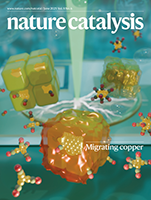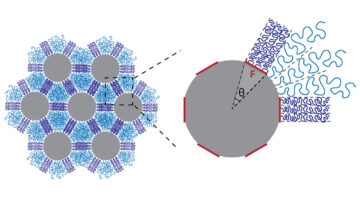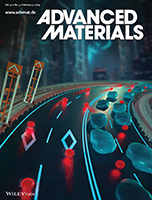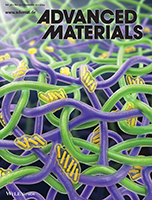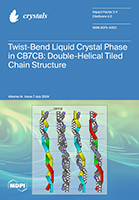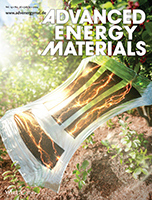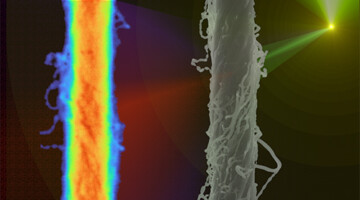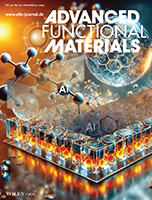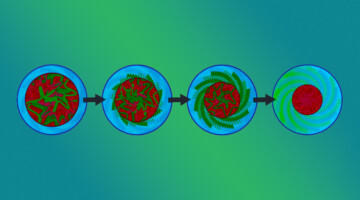In their work, Peidong Yang and colleagues reveal the dynamic evolution from faceted Cu nanocatalysts into metallic nanograins during CO2 reduction driven by the surface migration of electrogenerated copper carbonyl. Read more »
Building a Gated-Access Fast Lane for Ions
In organic conductors where charge is carried by both electrons and ions, scientists have discovered a way to make the ions move more than ten times faster than in comparable ion-transport methods. The results could apply to a host of areas, including improved battery charging, biosensing, soft robotics, and neuromorphic computing. Read more »
A New Way to Engineer Composite Materials
A new study led by researchers at Berkeley Lab outlines a way to engineer pseudo-bonds in materials. Instead of forming chemical bonds, which is what makes epoxies and other composites so tough, the chains of molecules entangle in a way that is fully reversible. Read more »
Local Chemical Enhancement and Gating of Organic Coordinated Ionic-Electronic Transport
Record ion mobility and conductivities are revealed within a nanoscopic interfacial superhighway of an organic mixed ionic-electronic conductor. Fast ion transport can be controlled by hydrophobicity of molecules local to this channel, effectively gating ion access to the superhighway. This mechanism is used in a novel chemical sensing device which detects the dynamics of a local, buried chemical reaction. Read more »
Jamming Giant Molecules at Interface in Organic Photovoltaics to Improve Performance and Stability
Giant molecule acceptors (GMAs), known for their large size and intricate functional structures, are an emerging focus in materials science. Through implementation of an interface-enhanced layer-by-layer fabrication strategy, we have successfully demonstrated that GMA with designed electronic structure at interfaces can effectively improve OPV device performance. Read more »
Double-Helical Tiled Chain Structure of the Twist-Bend Liquid Crystal Phase in CB7CB
The structure of the twist-bend (TB) phase of the bent dimer CB7CB and its mixtures with 5CB is characterized, revealing a hidden invariance of the self-assembly of the TB structure. Remarkably, the distance along the length for a single turn of this helix is given by 2πRmol, where Rmol is the radius of the bend curvature of a single all-trans CB7CB molecule. Read more »
Establishing Co-Continuous Network of Conjugated Polymers and Elastomers for High-Performance Polymer Solar Cells with Extreme Stretchability
Researchers developed intrinsically stretchable organic solar cells (IS-OSCs) with exceptional mechanical robustness, by constructing co-continuous networks of conjugated polymers (D18) and elastomers (SEBS) in photoactive layers. The resulting IS-OSCs preserve 86% of their initial efficiency at 50% strain, demonstrating potential for wearable applications. Read more »
How Processing Affects Structure in Composite Nanotube Yarns
Using the ALS, researchers found quantitative correlations between processing parameters and the structure of ultrafine, polymer-reinforced carbon-nanotube fibers. The work will facilitate the production of high-strength materials, including those needed for positioning target capsules for fusion research at the National Ignition Facility. Read more »![]()
![]()
Influences of Metal Electrodes on Stability of Non-Fullerene Acceptor-Based Organic Photovoltaics
Researchers investigate interfaces in an organic photovoltaic device, revealing that the aluminum (Al) top electrode undergoes thermally activated diffusion into inner layers forming ionic and organo-metallic-like species, compromising long-term device performance. Chemical degradation process is characterized by 27Al solid-state NMR and X-ray photoelectron spectroscopy. Read more »
Insight into How Thermoresponsive Nanomaterials Work
By combining soft x-ray scattering with electron microscopy, researchers learned how nanoscale polymer assemblies in solution restructure in response to heating. The approach can be generalized to many complex, solution-phase, nanoscale processes, and holds promise for driving advances in applications from drug delivery to catalysis. Read more »![]()
![]()
- 1
- 2
- 3
- 4
- Next Page »
